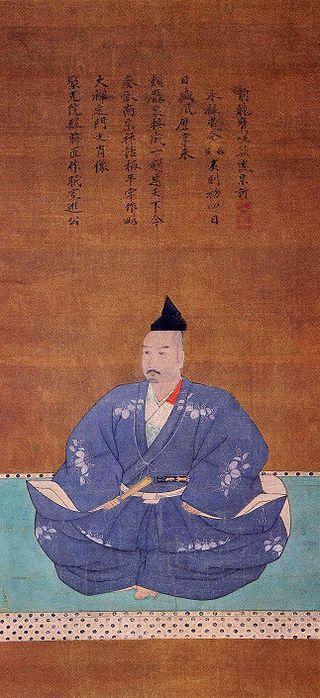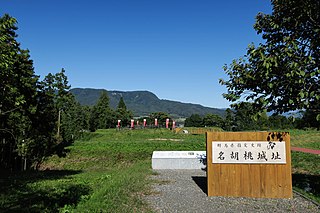Related Research Articles

Kamiizumi Nobutsuna,, born Kamiizumi Ise-no-Kami Fujiwara-no-Hidetsuna, was a samurai in Japan's Sengoku period famous for creating the Shinkage-ryū school of combat. He is also well known as Kamiizumi Isenokami which was his name as a samurai official for a period of time.

Miyoshi Nagayoshi, eldest son of Miyoshi Motonaga, was a Japanese samurai and powerful daimyō who ruled seven provinces of Kansai.

Maebashi is the capital city of Gunma Prefecture, in the northern Kantō region of Japan. As of 31 August 2020, the city had an estimated population of 335,352 in 151,171 households, and a population density of 1100 persons per km2. The total area of the city is 311.59 km2 (120.31 sq mi). It was the most populous city within Gunma Prefecture until Takasaki merged with nearby towns between 2006 and 2009. Maebashi is known to be the "City of Water, Greenery and Poets" because of its pure waters, its rich nature and because it gave birth to several Japanese contemporary poets, such as Sakutarō Hagiwara.

Minowa Castle was a "hirayama"-style (castle located in the Misato neighborhood of the city of Takasaki, Gunma Prefecture, Japan. The ruins have been protected by the central government as a National Historic Site since 1987.

Kamiizumi Station is a passenger railway station in the city of Maebashi, Gunma Prefecture, Japan, operated by the private railway operator Jōmō Electric Railway Company.
Nagano Narimasa was a Japanese samurai retainer of the Uesugi clan during the Sengoku period and lord of Gunma. He was known for building Minowa Castle in 1526, and his skill at castle defense.

Maebashi Castle is a castle located in Maebashi, central Gunma Prefecture, Japan. At the end of the Edo period, Maebashi Castle was home to a branch of the Matsudaira clan, daimyō of Maebashi domain, although the castle was ruled by a large number of different clans over its history. The castle was also known as "Mayabashi-jō" (厩橋城), after the former name of Maebashi.

Instituto Educacional Centro Nippo Brasileiro is a Brazilian school in Oizumi, Gunma which serves kindergarten through 12th grade.
Marume Nagayoshi was a retainer of the Sagara clan in the Sengoku period and a swordsman in the early Edo period. He was considered one of the best pupils of Kamiizumi Nobutsuna, and went on to found the Taisha ryū school. He was sometimes known as Kurandonosuke and also as Ishimi Mamoru, but was best known as Marume Nagayoshi, which he was called in kōdan. His original name was Fujiwara, and his art name was Tessai. In his later years he shaved his head and went by the name of Ishimi Nyūdō Tessai.
Nirayama Castle is a hilltop castle, now largely ruins, built by Hōjō Sōun in the Izu Province in 1493.

Iimoriyama Castle was a Sengoku period mountain-top castle in Osaka Prefecture, Japan. Located on a 315.9 meter mountain. It was the original base of power for the Miyoshi clan.

Akutagawayama Castle was a Sengoku period mountain-top castle in Takatsuki, Osaka Prefecture, Japan. Located on a 182.6 meter mountain.

Mino Kaneyama Castle was a Sengoku period Japanese castle located in Kani, Gifu Prefecture, Japan. In 1981, the ruins were designated as a National Historic Site. It was also known as Karasumine Castle

Hamada Castle is a castle structure in Hamada, Shimane Prefecture, Japan.

Chiran Castle is a castle structure in Chiran, Kagoshima, Minamikyūshū, Kagoshima Prefecture, Japan. The site was designated a National Historic Site.

Tochio Castle was a castle structure in Nagaoka, Niigata, Japan. The site is located on a 227-meter mountain. Young Uesugi Kenshin spent five years in the castle.

Kōkukuji Castle was a Sengoku period yamashiro-style Japanese castle located in the Negoya neighborhood of the city of Numazu, Shizuoka prefecture. The ruins have been protected as a National Historic Site since 1975.

Nagurumi Castle is a castle structure in Tone, Gunma Prefecture, Japan. The castle played historically important role because invasion of the castle by the Later Hōjō clan caused Siege of Odawara (1590).

Minato Castle was a Japanese castle in what is now Tsuchizaki Minato, Akita, Akita Prefecture, Japan. Throughout the Muromachi period, Minato Castle was home to the Ando clan, daimyō of Akita Domain, rulers of northern Dewa Province.
Kitajō Takahiro, also known as Mōri Takahiro, was a Japanese samurai and commander of the Sengoku period.
References
- ↑ "上泉城(群馬県前橋市)の見どころ・アクセスなど、お城旅行と歴史観光ガイド | 攻城団(日本全国のお城情報サイト)". 攻城団 (in Japanese). Retrieved 2022-02-20.
- ↑ "上泉信綱(かみいずみのぶつな)|前橋市". www.city.maebashi.gunma.jp (in Japanese). Retrieved 2022-02-20.